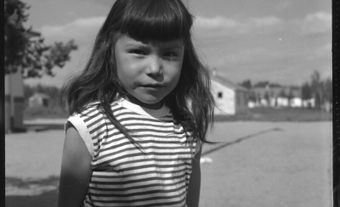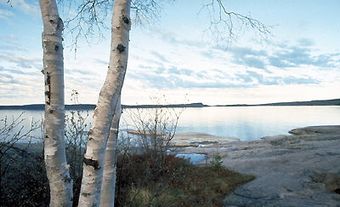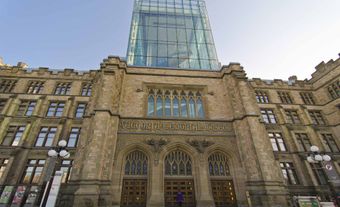Thunder Bay, ON, incorporated as a city in 1970, population 108,843 (2021 census), 107,909 (2016 census). The City of Thunder Bay was created by the amalgamation of the cities of Fort William and Port Arthur and the townships of Neebing and McIntyre. It is located in northwestern Ontario on the west shore of the Lake Superior bay of the same name. Thunder Bay is situated on the traditional territory of the Anishinaabeg, and the land is covered by the Robinson-Superior Treaty. The Port of Thunder Bay is a western stop along the Great Lakes-St Lawrence Seaway. The region’s geography is dominated by the rocks, lakes and forests of the Canadian Shield. Surrounding communities depend on tourism or resource extraction and look to Thunder Bay for a wide variety of services.
Settlement and Development
Paleo-Indian hunters followed herds of caribou into the Thunder Bay area about 10,000 years ago, at the end of the Wisconsin glaciation. Stone tools and weapons, copper artifacts and pottery made by these groups and their descendants have been identified at numerous archaeological sites in the district. At the time of the first European contact in the 17th century, the local population consisted of bands of Ojibwa. The bay's name refers to the Thunderbird that is part of their folklore.
In 1683, French fur trader Daniel Dulhut built Fort Caministigoyan beside the Kaministiquia River, which flows into western Lake Superior. The fort was used by French traders and explorers such as Jean-Baptiste Gaultier de La Vérendrye. In 1803, the North West Company (NWC) built Fort William, the first permanent European settlement on Thunder Bay.

Between 1805 and 1821, Fort William was the centre of the NWC fur-trading empire. Its importance declined when the NWC amalgamated with the Hudson's Bay Company in 1821. Around the same time, the fur trade began to slow, and mining companies took an interest in copper and other natural resources in the Thunder Bay area. Ojibwa leaders petitioned the government over concerns about mining permits being issued on Indigenous territory. Negotiations between chiefs and government commissioners resulted in the signing of the Robinson-Superior Treaty in 1850. Under the provisions of the treaty, a reserve called Fort William First Nation was established in 1853. The reserve was located to the south of Fort William, and exists to this day as neighbour to the city of Thunder Bay (see Reserves in Ontario). In 1870, the Immaculate Conception Orphan Asylum was established on Fort William First Nation to educate Ojibwa girls. The orphanage was destroyed by fire in 1895, and was rebuilt as St. Joseph’s Indian Residential School (see Residential Schools in Canada).

In 1869, engineer Simon Dawson established a camp just north of Fort William. The camp was the eastern end to Dawson Road, a land and water route connecting Lake Superior to the Red River in what is now Manitoba. The following year the camp was named Prince Arthur’s Landing. In 1883, the site was renamed Port Arthur when it became the location of the Canadian Pacific Railway’s first grain elevator.
Better docking facilities and the discovery of silver meant Port Arthur grew faster than Fort William. However, in 1875 construction of a Canadian Pacific Railway station at Fort William breathed new life into the community. Port Arthur was incorporated as a town in 1884, Fort William in 1892, and both settlements were granted civic charters in 1907.
In 1905, the federal government took control of the entire Fort William First Nation reserve to allow the Grand Trunk Pacific Railway to build a station. Reserve residents were relocated; however, the GTPR went bankrupt and the station was never completed. St. Joseph’s Indian Residential School also changed locations, moving from the reserve to the city of Fort William, and it remained in operation until 1966.
Fort William and Port Arthur developed similarly but separately until 1970 when, under pressure from the provincial government, they were incorporated as the city of Thunder Bay.
Cityscape

Thunder Bay sits on the floodplains of the lower Kaministiquia, Neebing and McIntyre rivers. To the south is Mount McKay and the Nor'Westers, a range of steep-sided, flat-topped hills. To the east, about 25 km across the bay, is the Sibley Peninsula. The peninsula includes Nanibijou, or The Sleeping Giant, a rock formation about 33 km long with vertical rock faces rising over 300 m out of the lake.
Did you know?
According to Ojibwa legend, the spirit Nanibijou told the tribe about a silver deposit at Silver Islet, a small island at the tip of the Sibley Peninsula. In exchange for the information, Nanibijou asked that the location of the silver be kept a secret from White men. If the White men found out, Nanibijou would turn himself to stone. However, the silver accessories of the Ojibwa soon became the envy of neighbouring tribes, and eventually a Sioux warrior discovered the location of the mine. On his way home to tell the secret to his people, he met White men who convinced him to reveal the deposit’s location. When the White men approached Silver Islet, a storm erupted and a stone formation in the shape of a sleeping giant appeared.
Amalgamation produced a city with two downtown cores, each with older residential districts and separate suburban developments. Industrial land is concentrated along the waterfront and in the Westfort and Intercity neighbourhoods. Balmoral Industrial Park was created in the mid-1970s to encourage the establishment of new light industries. However, it has been more successful in attracting commercial, service and retail activities.
Population
The late 19th-century pioneer population of Fort William and Port Arthur was mostly male. The number of residents fluctuated wildly in response to changing employment opportunities in railway construction, shipping and silver mining. From about 3,000 inhabitants each in the late 1890s, the two cities grew rapidly up to 1914, with Fort William in the lead. At amalgamation, each had close to 50,000 residents.

Early settlement was essentially Anglo-Saxon and that group controlled the city's economic and political establishment until the Second World War. According to the 2021 census, a large segment of the population identifies as English (22.6 per cent), Scottish (19.3 per cent) or Irish (17.9 per cent). The city also has relatively large Italian, French, Ukrainian, Finnish, German and Polish immigrant populations. As of 2021, visible minorities accounted for 7.5 per cent of Thunder Bay residents, with South Asian, Chinese and Black people making up the largest communities within this group. In addition, Indigenous peoples account for 14.1 per cent of the population.
Inquests into First Nations Deaths
Thunder Bay has the highest proportion of Indigenous residents among major cities in Canada. Census data likely under represents the number of Indigenous people in Thunder Bay at any given time, as many Indigenous people stay in Thunder Bay on a temporary basis, and are therefore not captured in the census.
Indigenous people travel from surrounding communities to Thunder Bay to access services that are inadequate or unavailable in their home communities, including medical services, education and employment. As most First Nation communities in northwestern Ontario don’t have secondary schools, many young Indigenous students move to Thunder Bay to attend high school, often staying in boarding homes. Dennis Franklin Cromarty, a First Nations high school, was established in Thunder Bay in 2000.
Between 2000 and 2015, seven First Nations youth died while attending school in Thunder Bay. In 2016, the Office of the Chief Coroner completed an inquest into the deaths. The inquest examined the deaths of Jethro Anderson, Curran Strang, Paul Panacheese, Robyn Harper, Reggie Bushie, Kyle Morriseau and Jordan Wabasse. It concluded that three of the deaths were accidental, and the cause of death for the remaining four were undetermined.
In 2015, an Indigenous man named Stacy DeBungee was found dead in the McIntyre River. Within hours of discovering the body, the Thunder Bay Police Service deemed the death non-suspicious. DeBungee’s death and the subsequent police investigation led to complaints filed with the Office of the Ontario Independent Police Review Director (OIPRD). The Office conducted a review of the relationship between the Thunder Bay Police Service (TBPS) and Indigenous communities. The review, completed in 2018, found that TBPS failed to properly investigate DeBungee’s death. It concluded that racism may have influenced police to prematurely conclude that DeBungee died as a result of drowning, instead of investigating the death as a potential homicide. The OIPRD report found that systemic racism exists at an institutional level in the city.
Racism in Thunder Bay has been explored in various media, including Canadaland’s “Thunder Bay” podcast and Tanya Talaga’s book Seven Fallen Feathers: Racism, Death, and Hard Truths in a Northern City. In 2019, the Globe and Mail opened a bureau in Thunder Bay in response to the OIPRD’s report on systemic racism.
Economy and Labour Force
Historically, industries such as natural resource extraction, processing and transportation were important components of the Thunder Bay economy. The forest industry, including pulp and paper mills and wood-processing plants, was the largest industrial employer. Today, however, the industries employing the most Thunder Bay residents are health care and social assistance, retail, education, and public administration.
Transportation

Fort William was the hub of the fur-trade route to the Northwest. It gained new importance in 1885 when the Canadian Pacific Railway was completed, and a steadily increasing flow of western grain came into the region for shipment east. With the completion of the Manitoba to Port Arthur section of the Canadian Northern Railway (1902), Thunder Bay became one of the world's largest grain ports. Lakehead Harbour benefited from the opening of the St. Lawrence Seaway (1959) and the Keefer Terminal, a lake and ocean freight-handling dock (1962). Thunder Bay remains one of the busiest ports in Canada.
The CPR and CNR continue to link Thunder Bay to the national rail network, although passenger services were discontinued in 1990. The Trans-Canada Highway is the only east-west route through the area, and as a result, all road traffic to and from other parts of Canada must pass through Thunder Bay. Air Canada and WestJet combine with local carriers, such as Bearskin Airlines, to provide national and regional air services. The First Nations-owned airline Wasaya Airways provides important services for the First Nations communities north and west of Thunder Bay.
Government and Politics
The municipal government is headed by a city council elected every four years, consisting of a mayor (elected at large) and 12 councillors (five elected at large, and one from each of the 7 wards).
Cultural Life
Thunder Bay has become the regional centre for cultural life in northwest Ontario. In the heart of the city is the Thunder Bay Community Auditorium, featuring performances by the Thunder Bay Symphony Orchestra and the Fort William Male Choir. There is one professional theatre company, Magnus Theatre, as well as a variety of amateur companies. Thunder Bay is also the site of a casino owned by Vancouver-based Gateway Casinos & Entertainment Ltd.
The Thunder Bay Art Gallery is a national exhibition centre for Indigenous art. There are also several artist-run or private galleries exhibiting local art. Local history is kept alive at the Thunder Bay Historical Museum at Fort William Historical Park, a replica of the 19th-century fur-trading post. In addition, the Founders' Museum takes the form of a northwestern Ontario pioneer village from the early 1900s. The city's cultural diversity is promoted through the activities of various ethnic groups and an annual multicultural festival.
Thunder Bay is home to the Thunder Bay North Stars, a Junior A hockey team in the Superior International Junior Hockey League. The Staal brothers, Eric, Marc, Jordan and Jared, are from Thunder Bay and all four were drafted to the National Hockey League. The city is also home to the Thunder Bay Border Cats, the only Canadian baseball team in the summertime Northwoods League for top collegiate players. Known for its curling facilities, the curling teams of Al Hackner won world championships in 1982 and 1985, and the team of Heather Houston in 1989. Local athletes have successfully competed in Olympic, Commonwealth and Pan-American games. One example is Curt Harnett, who won medals for cycling in three Olympic games. The city has hosted the Ontario Winter Games (1976), the Canadian Figure Skating Championships (1980), several World Cup ski-jumping meets, the Canada Summer Games (1981) and the Canadian Women's Curling Championship (1996). In 1995, Thunder Bay was the site of the World Nordic Games.
Post-secondary education is provided by Confederation College and Lakehead University. The Lakehead campus shares a medical school with Laurentian University in Sudbury.

 Share on Facebook
Share on Facebook Share on X
Share on X Share by Email
Share by Email Share on Google Classroom
Share on Google Classroom



